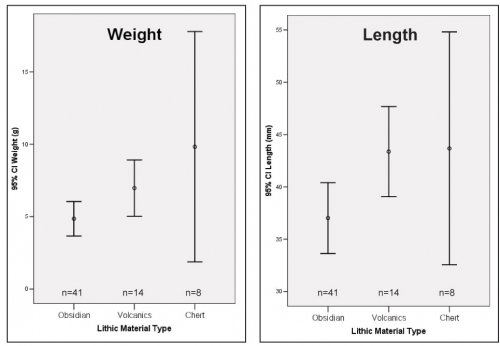Are the changes in material type for projectile points significant?
The degree to which material type is more commonly used in later time periods is informative and the counts of projectile point raw material type by time period can be used to explore whether the apparent patterns in raw material use through time are the result of random chance. The data from Table 6-14 above must be aggregated and simplified to allow a Chi-Squared test.
|
Periods |
Obsidian |
Fine-Grained Volcanics |
Chert & Chalcedony |
Total |
|
Early Archaic |
16 |
3 |
3 |
22 |
|
E-M & M. Archaic |
26 |
8 |
9 |
43 |
|
Late Archaic |
7 |
13 |
2 |
22 |
|
Term Archaic - Late Horizon |
227 |
10 |
17 |
254 |
|
Total |
276 |
34 |
31 |
341 |
Table 6-16. Aggregated Projectile Point Styles by Material Type for the project area.
The differences between aggregated cultural periods as indicated by diagnostic projectile points and their respective material types are extremely significant (c2= 85.959, p> .005). This analysis is complicated by the fact that obsidian projectile points were very small in comparison to the non-obsidian points because obsidian points were used predominantly to make very small types of projectile points: the Series 5 group of points (Klink and Aldenderfer 2005: 47-53). If Series 5 projectile points are excluded material types can be compared more consistently by weight and length throughout the Archaic and across space. Table 6-14 under row "Series 1-4 Only" displays the count and weight of the comparable more projectile point types. Error bars for size measures on these Series 1-4 points are shown below.
Figure6-5. Complete projectile point weights and lengths by material type for the entire project area. Series 5 projectile points are excluded and chalcedony is combined with chert.
The significance of the differences in mean length and weight between material types was evaluated statistically. An analysis of variance was conducted on these distributions comparing obsidian, fine-grained volcanics, and chert projectile points. The ANOVA test revealed that the difference observed in the mean weight between the three material type groups was extremely significant (F=5.152, p> .0005).
Such comparisons between obsidian and other material types bring up a host of issues that may be influencing the analysis. These issues include the fine knapping quality of obsidian and the likelihood that the material would be retouched and recycled. Additionally, pressure flaking was most often observed on obsidian artifacts, and along with the fine conchoidal fracture of obsidian, allowed smaller pieces of obsidian to remain viable tools. Finally, a sampling bias during survey might have been introduced by the high observability of obsidian by archaeologists.
All things being equal, distance-decay models would predict that in the immediate vicinity of a source of raw material the artifacts that have complete scar coverage and are apparently "completed" would be larger, on average, than other material types. Curiously analysis shows that even close to the obsidian source obsidian projectile points are smaller than non-obsidian points. Distance-decay models also predict that far from the obsidian source obsidian tools and flakes will be consistently smaller than mean tool weights made from locally available lithic materials. Data from the consumption zone including the Qillqatani rock shelter (data presented in Chapter 3 (Section 3.4.2), as well as other lithic evidence from the Ilave Valley (Section 3.4.4), show the expected pattern: obsidian tools are significantly lighter than tools of other, more locally available, material types.

